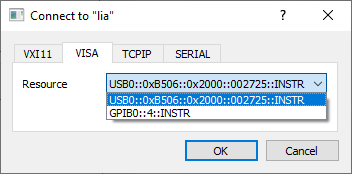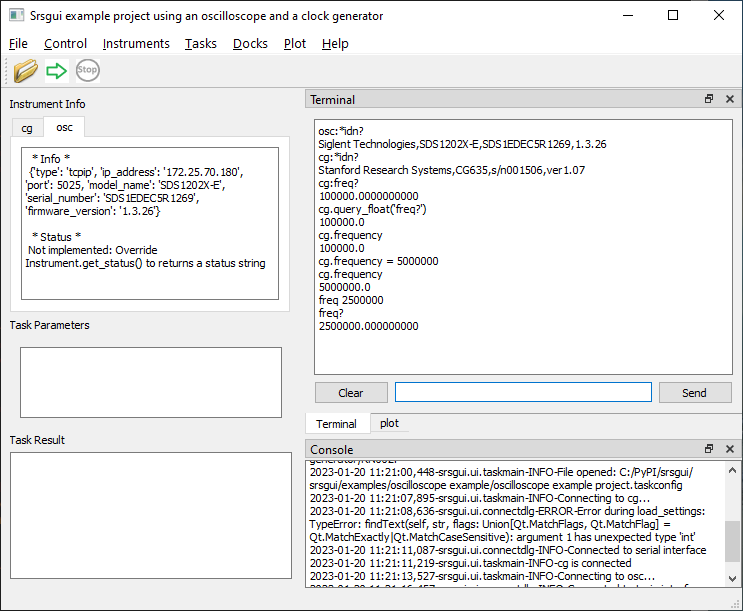Defining an instrument class
An instrument class is a subclass derived from the
Instrument class.
The _IdString must be defined.
(This is used to check if a connected
instrument is of the proper type to be used with the subclass).
from srsgui import Instrument
class CG635(Instrument):
_IdString = 'CG635'
_term_char = b'\r' # Add this line if the carriage return is the termination character
# of the instrument, instead of the line feed (ASCII: 0x10, b'\n').
- If the instrument has:
the *IDN? remote command, and
either RS232 serial communication or Ethernet TCPIP communication port available,
the instrument can be connected and used in task scripts and in the terminal,
with 4 lines of definition, as shown above. If it does not have a *IDN? remote command,
the check_id() method in Instrument
class needs to be reimplemented.
Available_interfaces
available_interfaces defines what communication interfaces are available for the instrument.
The base Instrument class has the following
definition for serial and TCP/IP communication interfaces:
available_interfaces = [
[ SerialInterface,
{
'port': FindListInput(),
'baud_rate': IntegerListInput([9600, 115200]),
'hardware_flow_control': BoolInput(['Off', 'On'])
}
],
[ TcpipInterface,
{
'ip_address': Ip4Input('192.168.1.10'),
'port': IntegerInput(23)
}
]
]
If your instrument needs interfaces other than serial and TCP/IP,
srsgui allows additional communication classes derived from the
Interface class.
Currently there are two external communication interfaces available from the
srsinst.sr860 package: Vxi11Interface and VisaInterface,
which covers for VXI11, GPIB and USB-TMC. You can import the interface modules
from srsinst.sr860 .
available_interfaces in the SR860 class is defined as following:
available_interfaces = [
[ Vxi11Interface,
{
'ip_address': Ip4Input('192.168.1.10'),
}
],
[ VisaInterface,
{
'resource': FindListInput(),
}
],
[ TcpipInterface,
{
'ip_address': Ip4Input('192.168.1.10'),
'port': 23
}
],
[ SerialInterface,
{
'port': FindListInput(),
'baud_rate': IntegerListInput([9600, 19200, 38400, 115200,
230400, 460800], 3)
}
],
]
Defining available_interfaces is all you need to do to get a customized
dialog box opened for the instrument in srsgui application.

For VisaInterface, you have to get PyVISA working before running srsgui application.
This involves installation of the PyVISA package and its backend library.
Refer to PyVISA documentation for installation details.
Interacting with an instrument
Once an Instrument class is defined, you can connect to and communicate with the instrument
via keyboard by launching a Python interpreter from your command prompt:
C:\srsgui>python
Python 3.8.3 (tags/v3.8.3:6f8c832, May 13 2020, 22:37:02) [MSC v.1924 64 bit (AMD64)] on win32
Type "help", "copyright", "credits" or "license" for more information.
>>>
>>> from srsinst.sr860 import SR860
>>> from srsgui import SerialInterface
>>> SerialInterface.find()
['COM3', 'COM4', 'COM256']
>>> lia = SR860('serial','COM4',115200, False)
>>> lia.query_text('*idn?')
'Stanford_Research_Systems,SR865A,002725,v1.34'
>>> lia.disconnect()
>>>
>>> from srsinst.sr860 import VisaInterface
>>> VisaInterface.find()
['USB0::0xB506::0x2000::002725::INSTR', 'GPIB0::4::INSTR']
>>> lia.connect('visa', 'USB0::0xB506::0x2000::002725::INSTR')
>>> lia.query_text('*idn?')
'Stanford_Research_Systems,SR865A,002725,v1.34\n'
>>>
Furthermore, by adding the instrument to a .taskconfig file
and opening the .taskconfig file in the srsgui application,
you can use the built-in terminal to interact with multiple instruments at once,
and use high level Instrument class attributes and methods.
Below is an image of the srsgui application captured with the example project opened.
As you can see, you can interact with the clock generator and oscilloscope in many ways.
You can see two examples of commands sent to the oscilloscope osc:
\*idn?, and sara?
as well as two commands sent to the the clock generator cg
\*idn?, and freq(?).

Component, Commands and IndexCommands
Instrument class uses
Component class,
Command classes and
IndexCommand classes
to organize the functionality of an instrument.
If you have to deal with hundreds of remote commands to use an instrument remotely, organizing them in a manageable way is crucial. Srsinst.sr860 package shows how these convenience classes are used to organize a large set of remote commands.